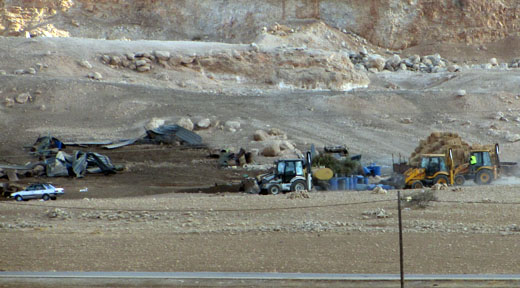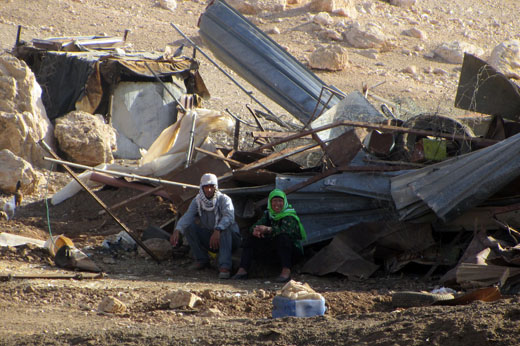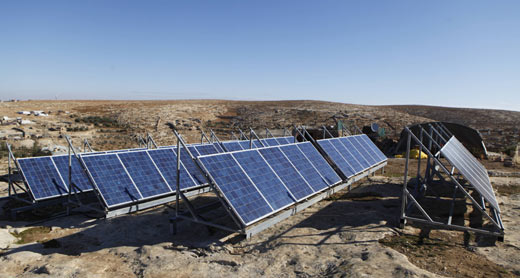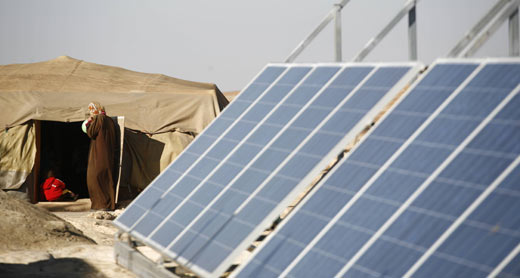Civil Administration demolishes all homes of Khallet Makhul community in Jordan Valley
 Friday, October 11, 2013 at 11:13PM
Friday, October 11, 2013 at 11:13PM http://www.btselem.org/node/138818
23 September 2013 Updated 7 October 2013 B'Tselem report
Update: On 24 September 2013, Adv. Tawfiq Jabareen applied to the Israeli High Court of Justice on behalf of the residents of Kh. Khallet Makhul, petitioning for an interim injunction that would prevent the expulsion of the villagers. On the very same day, the High Court issued an interim injunction against the expulsion of the villagers or the demolition of their homes by the Civil Administration or the military. According to the court, the interim injunction does not apply to demolitions necessary on urgent military grounds or on unambiguously operational security matters that cannot be postponed.
Since the injunction was issued, the residents have erected several tents, some of which were then demolished by the military contrary to the High Court ruling. Additional attempts by humanitarian aid organization to furnish equipment to the residents have largely failed, with the equipment being either confiscated or destroyed. The situation on the ground on 6 October 2013: there are eleven alternate tents standing that some 15 Khallet Makhul men are using as dwellings as well as for tending the sheep now lambing. Due to the harsh conditions on site, the women and children of Khallet Makhul have been sleeping in the cities of Tubas and Tammun, but the women return to Khallet Makhul on a daily basis to help with the flocks.
On 16 Sept. 2013, the Civil Administration demolished all the structures of a Bedouin community living in Khirbet Khallet Makhul, which lies east of Tammun and about half a kilometer west of the settlement of Hemdat, in the Jordan Valley. According to the ten-family community, which consists of sixty members, including 25 minors, they have lived at the site for dozens of years and make their living off grazing flocks. All their structures were demolished, and they have since been sleeping in the open, with no shelter for themselves or for their livestock.

Civil Administration bulldozers at the site of Khallet Makhul. Photo: Atef Abu a-Rub, B'Tselem, 16 September 2013.
On 25 August 2013, Israel’s Supreme Court rejected a petition filed by community members to settle the legal status of all the structures they had built. In its ruling, the Court noted that the petition was to be rejected outright both for technical reasons, because it included 21 separate petitioners who do not share the same interest, and because they Court accepted the position of the respondents – the sub-committee for supervising construction in the Civil Administration, the Commander of Armed Forces in Judea and Samaria, and the Legal Adviser for Judea and Samaria – that the requests for building permits submitted by the petitioners were faulty and did not include documents proving their affiliation with the land.
Since the demolition, the army has prevented all attempts by community members and international aid agencies to erect tents and provide shelter. As of 22 Sept. 2013 – almost a week after the original demolition, the community members and their livestock have nowhere to live and are without shelter. Military forces are present in increased numbers near Khallet Makhul, apparently in order to prevent any further attempts to supply the community with tents or other equipment.
The demolition of this community’s entire infrastructure is part of Israel’s longstanding policy towards shepherd communities in the Jordan Valley. To promote that policy, the Civil Administration takes various measures to prevent the communities from staying in place and using the land:
- Palestinian residents of the Jordan Valley are barred access to most of the area on various grounds: “closed military zone” encompass military firing zones and areas inside the settlements' municipal boundaries, nature reserves or state land. Palestinians are forbidden to stay, build structures or graze flocks in these areas, which amount to approximately 85% of the Jordan Valley (excluding overlap).
- In the limited areas left to Palestinians, the Civil Administration has refrained from drawing up outline plans for the Palestinian communities living there. When they build structures without permits – having no other choice – the Administration issues demolition orders for the structures, some of which are executed. B’Tselem’s figures show that, from the beginning of 2006 to the end of April 2013, the Civil Administration demolished at least 315 residential units in Palestinian communities in the Jordan Valley, which housed at least 1,577 people, including at least 658 minors. For 225 of these people (including 102 minors), this was at least the second time that their home had been demolished. An unknown number of structures used for agriculture was also demolished.
- In addition to being barred from legal construction by the Civil Administration, the Palestinian communities in the Jordan Valley are usually also not connected to the water grid. They depend on the area’s sparse rainwater, which they collect in cisterns, and on buying water from private providers, who charge a very high price. As a result of this policy, the average water consumption in these communities is just 20 liters per capita a day, a far cry from the 100 liters per capita a day recommended by the World Health Organization (WHO).
- Since the summer of 2012, the military periodically orders a temporary evacuation of the communities that live in areas declared firing zones in the Jordan Valley, citing maneuvers as the reason. In evacuation orders handed to the communities, they were required to leave their residences for periods ranging from several hours to two days, with the note that if they did not comply, they would be forcefully evicted and their livestock confiscated, and they would be billed for the expenses of the eviction. By the end of May 2013, at least 20 such incidents took place.
This policy of removing the Palestinian population from the Jordan Valley is aimed, among other things, at establishing Israeli control of the area and annexing it de-facto to Israel, while exploiting its resources and minimizing Palestinian presence there. In the long-term, this is intended to ensure Israeli presence in the area, even within the framework of a diplomatic agreement.

Residents of Khallet Makhul next to their demolished homes. Photo: Atef Abu a-Rub, B'Tselem, 16 September 2013.
As the occupying power in the West Bank, Israel must enable the local residents to lead their daily lives. This includes enabling them to build homes legally and to use the water sources to which they are entitled. In addition, in the recent demolition at Khallet Makhul, the military even refused to allow the residents to rebuild their homes, and barred all humanitarian aid from reaching them, thus effectively sentencing the community to expulsion from their homes. However, expelling residents from their homes in an occupied territory is only permitted by international law under exceptional circumstances, such as urgent military necessity or protecting the local population. Even then, strict conditions apply: the expulsion must be temporary and the residents must be provided with reasonable alternative accommodation, to the extent possible, until they can return to their homes. In any case, the residents must be allowed to return home as soon as possible. Clearly, the expulsion of the residents of Khallet Makhul does not meet with any of these requirements, and no alternative solution has been offered them, in breach of Israel’s duties under international humanitarian law.
B’Tselem calls on the relevant Israeli authorities to enable the residents of Khallet Makhul to rebuild their homes and to continue graze their flocks, as they have done for decades, on the land from which the military is attempting to expel them.
------------------------------------------------------------------------------------------------------------------------------------

Israel’s Policy Dispossesses Jordan Valley Bedouins
By Moshe (Mossi) Raz, Al-Monitor Israel Pulse
October 03, 2013
In the 1980s, when I was a soldier doing regular army service, I was ordered to the Palestinian village of al-Jiftlick in the Jordan Valley. The village residents — so we were told — had received an order to demolish it, and we were to supervise and ensure that it was carried out. We expected the residents to refuse to carry out the order, and that we would be forced to clash with them. But when we reached the place, we watched them carrying out the demolition order on the village without need for our intervention and without connection to us. We were amazed at the way the residents reconciled themselves to the decision. The village, which had existed for hundreds of years, was re-established and destroyed over and over several times, as part of an intentional Israeli policy that we could not understand at the time.
I was reminded of al-Jiftlick about two weeks ago [Sept. 20] when I received a widely circulated email from the UN emissary to the area, who denounced the violence with which the diplomats were treated — diplomats who went to the Khirbet al-Makhoul village bringing assistance. Despite my close familiarity with the Occupied Territories, I had never heard of the village that was demolished the day before on the order of the High Court. The Israeli media did not report on the deed. It only rose to the headlines due to the confrontation that took place on the site.
Marion Fesneau-Castaing, the female French diplomat who slapped the IDF soldier in his face — an unacceptable act — succeeded in directing Israeli and world attention to the fact that the authorities demolished a village housing human beings including children, women and the elderly. Though that was, evidently, deemed unworthy of being reported — the slap received by the IDF soldier or the shove visited on the diplomat brought them much attention.
Palestinian Bedouins have been living in the Khirbet al-Makhoul village even before 1967, but this did not help them when the army came to evacuate them from their village. That they are Palestinians, like the rest of the desert residents in the occupied territories, harms them twice: They are weaker than the Bedouins classified as Israeli citizens, but because they are Bedouins, the Palestinians also take no interest in them.
Under the influence of the Allon Plan, which proposed to annex most of the Jordan valley, as far back as 1967 the IDF marked the Jordan Valley and southern Hebron Hills areas to remain within Israeli territory, since both areas were sparsely populated. Ever since, various governments have increased Israeli settlement there and forestalled Palestinian expansion. To prevent the Palestinians from spreading, fire practice areas were marked in some of the unsettled areas. Sometimes this was done, by accident or maliciously, in settled areas, too. Thus these communities were destined for evacuation and demolition, over and over again.
Most of the effort to secure Israeli control over the territory was effected through the good old, time-worn method: settlement. Kibbutzim and community villages were established in the Jordan Valley and these made the desert bloom. The settlers’ agriculture permeated almost everywhere in the area, including other fire practice areas and closed military zones. All this for one clear goal: to prevent Palestinians from living there. Thus, while the settlers who came from Israel take up more and more land, the indigenous Bedouin-Palestinians continue to be pushed back into their subsistence boundaries, which have not been updated for dozens and hundreds of years.
The declaration of a closed military zone, as in the case of al-Makhul, is only one way of putting obstacles in the paths of the native residents. In other cases, Israel announces the creation of a nature reserve or finds some other excuse, but the result is always the same: restricting Palestinian construction and demolishing Palestinian houses, even in places that existed before the Israeli “rule of law” reached them.
These acts do not only take place in the occupied territories. Similar actions were taken against Israeli citizens even on Israeli territory (though fewer in number): The al-Arakib village was demolished dozens of times with the claim of illegal construction, even though it was established before the state of Israel came into existence.
The cases of the Ikrit and Biram residents, who were removed from their homes 65 years ago for only a supposedly short time, have not yet been returned — in spite of a High Court of Justice decision. This, too, is an example of iniquity. The common denominator of all the casualties: They are always Palestinians by nationality — whether they have Israeli citizenship or are residents of the occupied territories.
The Israeli decision-makers must consolidate a more reasonable and humane policy. This cruelty towards the Bedouin population must stop. If, in the past, the decision-makers in Israel thought that the Jordan Valley would remain in their hands as part of a permanent settlement and therefore should be “Judaized,” reality hit them in the face: Former Prime Ministers Ehud Barak in 2000, and Ehud Olmert in 2008, both agreed, in effect, to evacuate the valley in exchange for a permanent agreement with the Palestinians.
The implication of that is the following: To facilitate such an agreement, the authorities must prevent an increase in the settler population — and not in the number of the indigenous residents. But even if in the future a decision is taken to evacuate Israelis from the area, one might hope that the state will no treat them with the same violent and inhumane policy which it adopted when destroying Bedouin villages.
Mossi Raz is a former Israeli politician who served as a member of the Knesset for Meretz. A well-known activist, Raz has served as secretary-general of Peace Now and director of the non-profit organization Ir Shalem. In 2010, Raz along with colleague Maysa Baransi-Siniora was awarded the Outstanding Contribution to Peace prize by the International Council for Press and Broadcasting at the International Media Awards in London for his work with All for Peace Radio.
-----------------------------------------------------------
Civil Administration threatens alternative energy projects in southern Hebron Hills
http://www.btselem.org/planning_and_building/20120325_alternative_energy_infrastructure

Photo: Tomer Applebaum, Mantiqat She'b al-Baten, December 2011
Construction of these alternative energy structures began in 2009 in ten additional villages in this area, all by the Israeli organization Comet-ME, with German government funding and aid from the New Zealand government and Danish and Swiss NGOs. The structures supply villagers’ basic electricity needs using renewable solar and wind energy and do not pollute like diesel generators and kerosene lamps. Because Israel has avoided preparing master plans for these 16 villages, as for many other Palestinian communities, all structures, including these simple ones for clean energy, are built without a permit.
Nor does Israel allow these villages to connect to the advanced water and electricity grids it has built for nearby Israeli settlements, hence the village residents are forced to rely on water brought in by water tankers and on electricity from generators. This precludes even medical clinics; residents must travel outside the area for health services.

Photo: Tomer Applebaum, Mantiqat She'b al-Baten, December 2011
The Palestinian villages in the Masafer Yatta area date back to the 19th century. Some of their 1,300 residents live in caves and the rest in temporary structures, earning a living as shepherds. Israeli authorities tried to evict some of the area's residents in the late 1990s, but that effort remains frozen following an appeal by the Association for Civil Rights in Israel to Israel's High Court of Justice. The HCJ has yet to rule on this appeal. The solar panels and wind turbines meanwhile allow these villagers to refrigerate the homemade cheese they market and to light their homes at night.
In recent years, Israel has made efforts to reduce the Palestinian presence in Area C, where an estimated 150,000 Palestinians live. The Civil Administration planning policy for Area C has long prevented construction and development of Palestinian communities; about a year ago, the authorities intensified their efforts against these communities. The Civil Administration prepared a plan – currently on hold – to relocate the Bedouin communities near Ma’ale Adumim; in 2011, it focused on demolishing water infrastructure – cisterns and pools for rainwater collection – and sheds for animals, especially in the Masafer Yatta area and in the Bedouin communities in the Jordan Valley and around Ma’ale Adumim. Early in 2012 the Civil Administration began threatening demolition of the energy infrastructure in Area C Palestinian communities.
This policy notwithstanding, in March 2012 in its report to the Ad Hoc Liaison Committee, a gathering of international donor states and agencies, including the UN and IMF, the government of Israel claimed that Israel values the international community’s support for the development of Area C: Such projects, stated this report, “mainly those involving roads, environmental conservation, water, infrastructure and agriculture contribute to the welfare of the community and (protect) the environment.” The report also claimed that the Civil Administration approved most of the donor countries’ infrastructure projects in Area C. The same document claimed that between sixty to seventy thousand Palestinians live in Area C – whereas estimates by the UN and by Israeli NGOs fix the Palestinian population of Area C at 150,000.
Israel, as the occupying power, has an obligation to act for the benefit and welfare of the residents of the occupied territories, including their right to a decent standard of living. The intent to demolish basic infrastructure utterly contradicts this obligation.
----------------------------------------------------------------------------------------------------------------------------
6 Sept. '11: Civil Administration head contradicts State’s response to High Court
According to media reports, the head of the Civil Administration, Brig. Gen. Moti Almoz, has ordered an end to the demolition of Palestinian structures built without a permit. The order applies in Area C, some 60% of West Bank land where Israel is responsible for civil affairs, and is pending approval of Minister of Defense Ehud Barak. Almoz gave achieving “equality of enforcement” as the reason for the order, and noted that the Civil Administration was “very far” from enforcing the law in settlements and outposts where structures were built without permits. Almoz’s comments contradict the state’s announcements to the High Court of Justice, according to which the Civil Administration’s policy is based on "the principle of equal enforcement.”

Demolition of homes in the village of al-Hadidiya, Jordan Valley. Photo: 'Atef Abu a-Rub, B'Tselem, 21 June '11.
Demolition of homes and other structures belonging to Palestinians is part of Israel’s discriminatory planning policy, which makes it impossible, in practice, for Palestinians to build with permits in Area C. In some Palestinian communities, the outline plans prepared by Israel restrict construction to the existing built-up area, ignoring development needs. The communities were excluded from the planning process.
In large parts of the Jordan Valley and the southern Hebron hills, Israel has routinelydemolished structures in small Palestinian communities, on the grounds that they were built on land that Israel has defined as firing zones or nature reserves, or has seized as state land. In some cases, Palestinian communities had been living on the land since before Israel’s occupation of the West Bank in 1967.
At the same time, Israel has systematically refrained from enforcing the planning and building laws on settlements, even when massive construction has been carried out without a permit. This occurred, for example, in the Matityahu East neighborhood in Modi’in Illit, where hundreds of apartments were built without a permit. The state also refrains from law enforcement in settlements where structures were built without a permit on privately-owned Palestinian land, as occurred in the veteran settlement Ofra and in many outposts. According to data of the Ministry of Defense, of the Civil Administration, of and the State Comptroller’s Office, over the past 15 years, the authorities have uncovered thousands of building offenses in settlements. Figures provided to Peace Now by the Civil Administration indicate that, between 1996 and 2006, the Civil Administration opened 3,449 files involving building without a permit in settlements; enforcement action, including issuance of demolition orders, was taken in only 107, or three percent, of these cases.
B'Tselem rejects the false symmetry created by comparing Palestinian building in the West Bank and Israeli building in the settlements. Israel is obliged, under international humanitarian law, to enable Palestinian communities to build and develop according to their needs. It is not allowed to damage their property, including private and public structures. At the same time, international law forbids Israel to build settlements on the land it has occupied.
----------------------------------------------------------------------------------------------------------------------------------
Notes and links
Jordan valley support organisation.
Humanitarian fact sheet on the Jordan valley and Dead Sea area, from UN/OCHA, February 2012
Trapped in a mesh of regulations: life in Firing Zone 918
No aid for Palestinians: IDF rough up EU diplomats
Jordan valley, desert for Palestinians, lush land for Israelis
New Israeli road through Jordan valley announced as snub to PA, includes map.
 APJP |
APJP |  Post a Comment |
Post a Comment |
Reader Comments